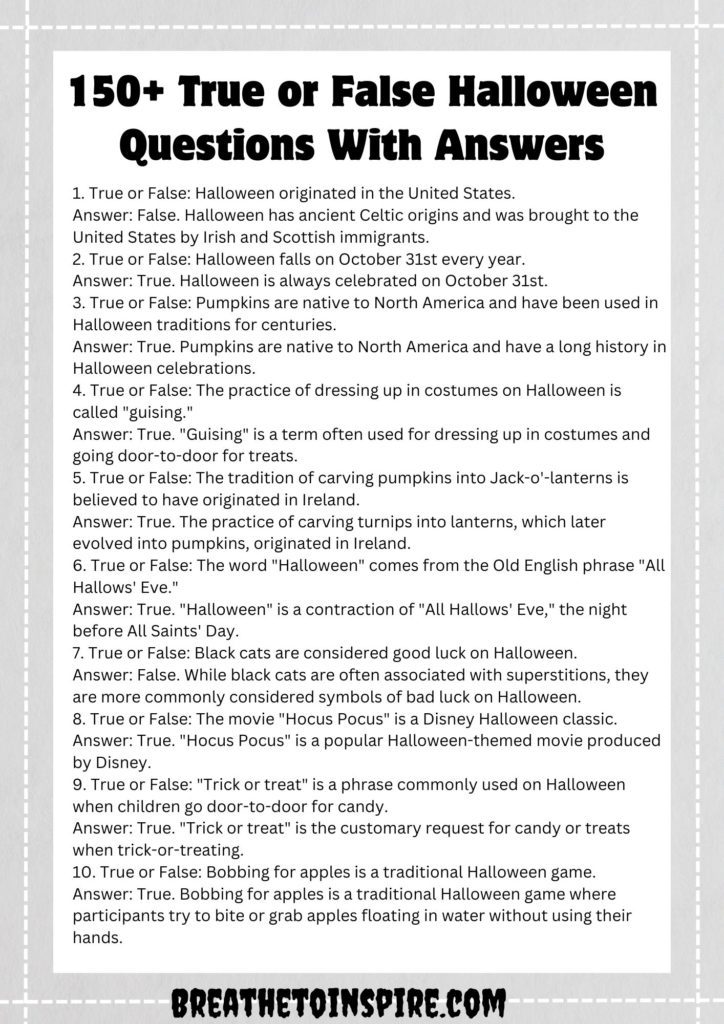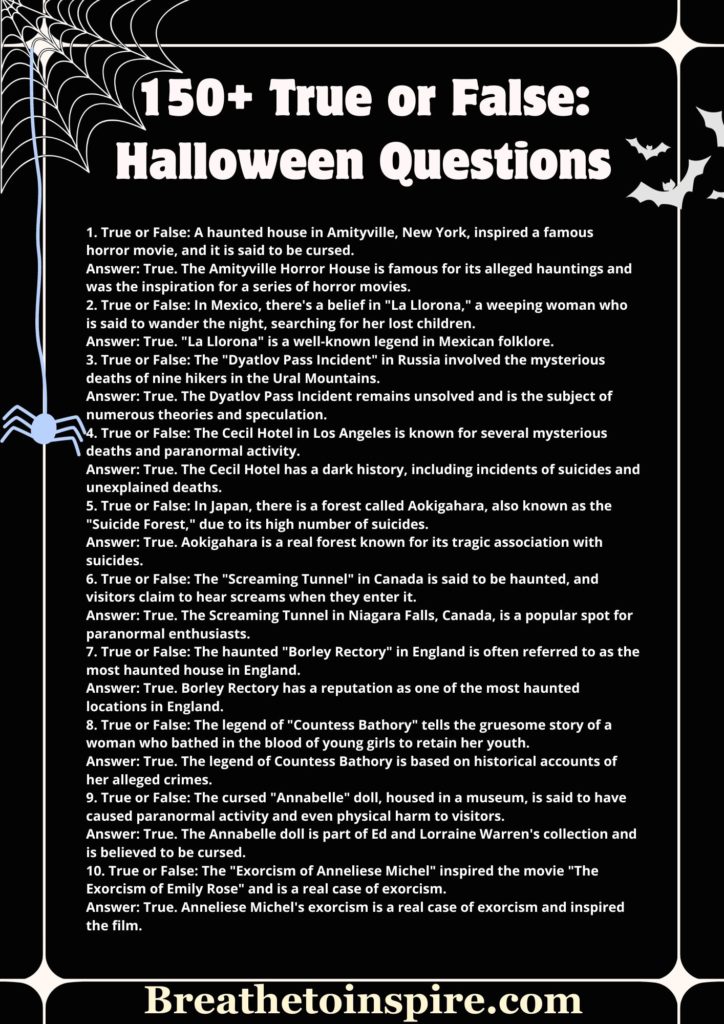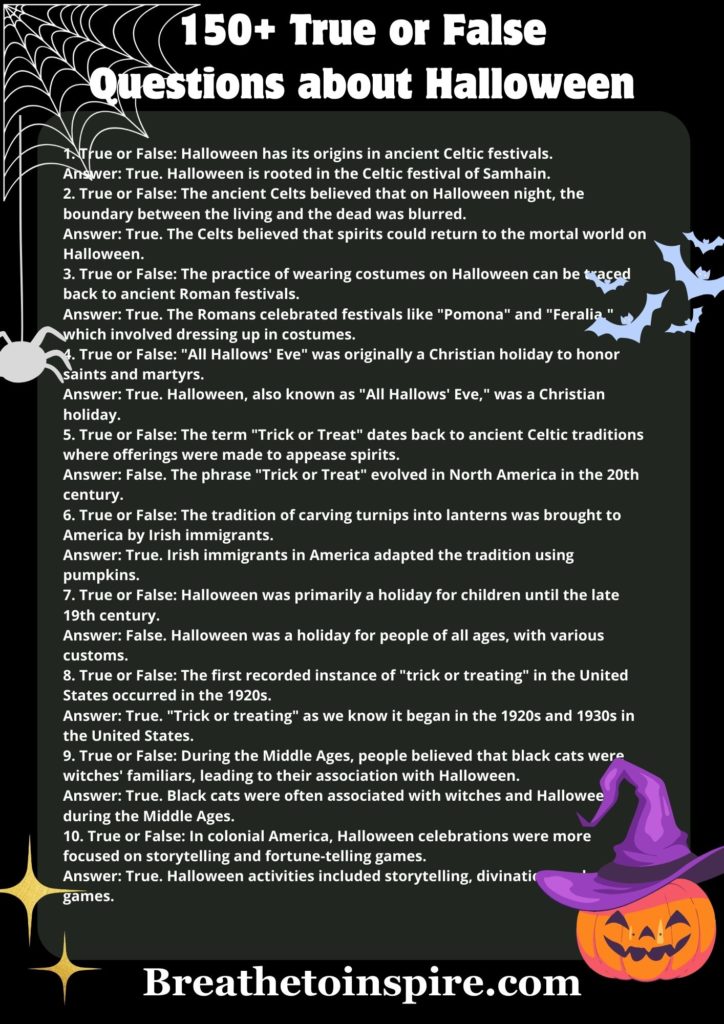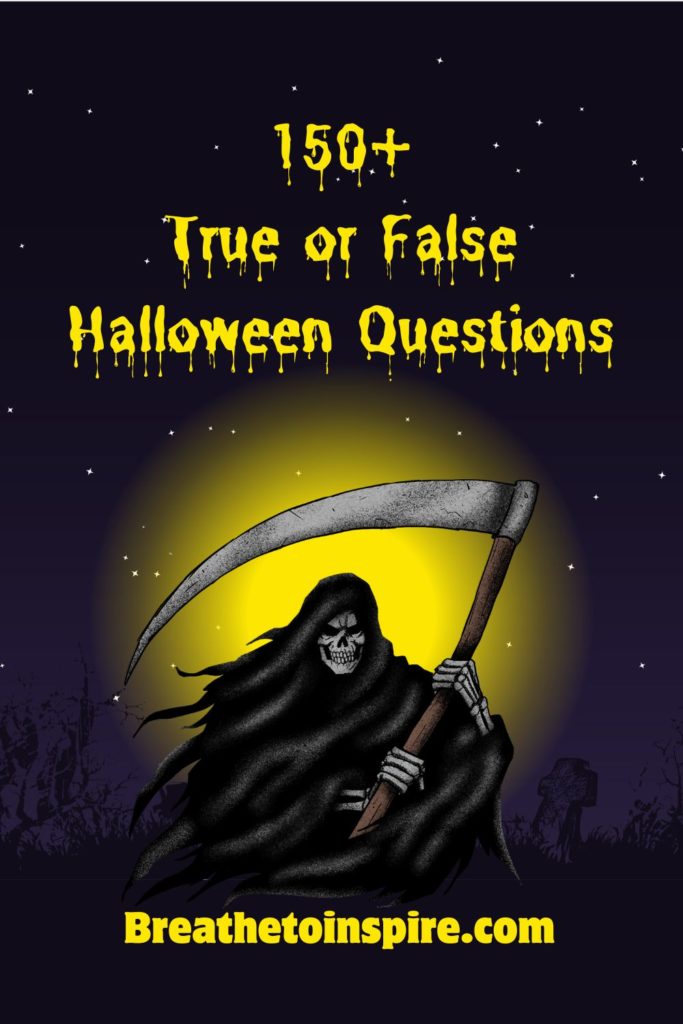Ah, Halloween, the night when the boundaries between the living and the dearly departed blur, and everyone becomes a little bit supernatural.
It’s a night of eerie enchantment, ghostly gatherings, and ghoulish giggles.
What better way to embrace the spirit of the season than with 125 true or false Halloween questions and answers that are bound to tickle your funny bone and spook your logic?
Get ready to test your knowledge and challenge your pals with these quirky queries, perfect for stirring up wickedly witty conversations at your Halloween bash.

125 True or false halloween questions
The following is a list of True or False Halloween Questions and Answers:
1. True or False: Halloween originated in the United States.
Answer: False. Halloween has ancient Celtic origins and was brought to the United States by Irish and Scottish immigrants.
2. True or False: Halloween falls on October 31st every year.
Answer: True. Halloween is always celebrated on October 31st.
3. True or False: Pumpkins are native to North America and have been used in Halloween traditions for centuries.
Answer: True. Pumpkins are native to North America and have a long history in Halloween celebrations.
4. True or False: The practice of dressing up in costumes on Halloween is called “guising.”
Answer: True. “Guising” is a term often used for dressing up in costumes and going door-to-door for treats.
5. True or False: The tradition of carving pumpkins into Jack-o’-lanterns is believed to have originated in Ireland.
Answer: True. The practice of carving turnips into lanterns, which later evolved into pumpkins, originated in Ireland.
6. True or False: The word “Halloween” comes from the Old English phrase “All Hallows’ Eve.”
Answer: True. “Halloween” is a contraction of “All Hallows’ Eve,” the night before All Saints’ Day.
7. True or False: Black cats are considered good luck on Halloween.
Answer: False. While black cats are often associated with superstitions, they are more commonly considered symbols of bad luck on Halloween.
8. True or False: The movie “Hocus Pocus” is a Disney Halloween classic.
Answer: True. “Hocus Pocus” is a popular Halloween-themed movie produced by Disney.
9. True or False: “Trick or treat” is a phrase commonly used on Halloween when children go door-to-door for candy.
Answer: True. “Trick or treat” is the customary request for candy or treats when trick-or-treating.
10. True or False: Bobbing for apples is a traditional Halloween game.
Answer: True. Bobbing for apples is a traditional Halloween game where participants try to bite or grab apples floating in water without using their hands.
11. True or False: Orange and black are the traditional colors associated with Halloween.
Answer: True. Orange and black are the traditional colors of Halloween.
12. True or False: The original purpose of wearing costumes on Halloween was to scare away evil spirits.
Answer: True. Wearing costumes on Halloween originated as a way to ward off evil spirits.
13. True or False: Bats are often associated with Halloween because they are nocturnal creatures.
Answer: True. Bats are commonly associated with Halloween due to their nocturnal habits and mysterious appearance.
14. True or False: The largest pumpkin ever recorded weighed over 1,800 pounds.
Answer: True. The largest recorded pumpkin weighed over 1,800 pounds, setting a world record.
15. True or False: Halloween is celebrated in the same way in every country around the world.
Answer: False. Halloween is celebrated differently in various countries, with different traditions and customs.
16. True or False: “Monster Mash” is a famous Halloween song.
Answer: True. “Monster Mash” is a popular Halloween-themed song.
17. True or False: Halloween is primarily a religious holiday.
Answer: False. Halloween has both religious and secular origins but is primarily celebrated as a secular holiday today.
18. True or False: The Salem witch trials took place on Halloween.
Answer: False. The Salem witch trials occurred in 1692 but not specifically on Halloween.
19. True or False: The Legend of Sleepy Hollow is a famous Halloween-themed short story written by Edgar Allan Poe.
Answer: False. “The Legend of Sleepy Hollow” is a famous Halloween-themed short story written by Washington Irving.
20. True or False: The concept of zombies has its origins in ancient Celtic folklore.
Answer: False. The concept of zombies is more closely associated with Haitian folklore.
21. True or False: Harry Houdini, the famous magician, died on Halloween.
Answer: True. Harry Houdini, the renowned magician and escape artist, died on October 31, 1926.
22. True or False: Candles are often placed inside Jack-o’-lanterns to light them up.
Answer: True. Candles or small lights are commonly placed inside carved pumpkins to create Jack-o’-lanterns.
23. True or False: Owls are a symbol of wisdom and are associated with Halloween.
Answer: True. Owls are often associated with wisdom and are a common symbol in Halloween decor.
24. True or False: Halloween is the second-largest commercial holiday in the United States, after Christmas.
Answer: True. Halloween is one of the largest commercial holidays in the United States.
25. True or False: In Mexico, the Day of the Dead (Dia de los Muertos) is celebrated as a Halloween-like holiday.
Answer: True. Dia de los Muertos in Mexico has similarities to Halloween, as it also involves remembering and honoring the deceased.
Also read: 500 Halloween questions to ask for fun conversation – 2023 (Icebreakers, Quiz and Trivia)

Creepy and scary True or False: Halloween questions
Here is a list of Creepy and Scary True or False: Halloween questions and answers:
1. True or False: A haunted house in Amityville, New York, inspired a famous horror movie, and it is said to be cursed.
Answer: True. The Amityville Horror House is famous for its alleged hauntings and was the inspiration for a series of horror movies.
2. True or False: In Mexico, there’s a belief in “La Llorona,” a weeping woman who is said to wander the night, searching for her lost children.
Answer: True. “La Llorona” is a well-known legend in Mexican folklore.
3. True or False: The “Dyatlov Pass Incident” in Russia involved the mysterious deaths of nine hikers in the Ural Mountains.
Answer: True. The Dyatlov Pass Incident remains unsolved and is the subject of numerous theories and speculation.
4. True or False: The Cecil Hotel in Los Angeles is known for several mysterious deaths and paranormal activity.
Answer: True. The Cecil Hotel has a dark history, including incidents of suicides and unexplained deaths.
5. True or False: In Japan, there is a forest called Aokigahara, also known as the “Suicide Forest,” due to its high number of suicides.
Answer: True. Aokigahara is a real forest known for its tragic association with suicides.
6. True or False: The “Screaming Tunnel” in Canada is said to be haunted, and visitors claim to hear screams when they enter it.
Answer: True. The Screaming Tunnel in Niagara Falls, Canada, is a popular spot for paranormal enthusiasts.
7. True or False: The haunted “Borley Rectory” in England is often referred to as the most haunted house in England.
Answer: True. Borley Rectory has a reputation as one of the most haunted locations in England.
8. True or False: The legend of “Countess Bathory” tells the gruesome story of a woman who bathed in the blood of young girls to retain her youth.
Answer: True. The legend of Countess Bathory is based on historical accounts of her alleged crimes.
9. True or False: The cursed “Annabelle” doll, housed in a museum, is said to have caused paranormal activity and even physical harm to visitors.
Answer: True. The Annabelle doll is part of Ed and Lorraine Warren’s collection and is believed to be cursed.
10. True or False: The “Exorcism of Anneliese Michel” inspired the movie “The Exorcism of Emily Rose” and is a real case of exorcism.
Answer: True. Anneliese Michel’s exorcism is a real case of exorcism and inspired the film.
11. True or False: The “Stanley Hotel” in Colorado served as inspiration for Stephen King’s novel “The Shining.”
Answer: True. The Stanley Hotel in Estes Park, Colorado, was the inspiration for Stephen King’s famous novel.
12. True or False: The “Chernobyl Exclusion Zone” in Ukraine is believed to be haunted by the spirits of those affected by the nuclear disaster.
Answer: True. Some people claim to have experienced paranormal activity in the Chernobyl Exclusion Zone.
13. True or False: The “Bell Witch” legend from Tennessee involves a malevolent spirit that tormented a family in the early 19th century.
Answer: True. The Bell Witch legend is a well-documented case of a haunting.
14. True or False: The “Skinwalker Ranch” in Utah is known for a wide range of paranormal phenomena, including UFO sightings and cattle mutilations.
Answer: True. Skinwalker Ranch has a history of strange and unexplained events.
15. True or False: The “Kuchisake-onna” is a Japanese urban legend about a woman with a split mouth who asks people if they think she is beautiful.
Answer: True. The Kuchisake-onna is a creepy urban legend from Japan.
16. True or False: The haunted “Myrtles Plantation” in Louisiana is said to be one of the most haunted homes in America.
Answer: True. Myrtles Plantation is renowned for its paranormal activity.
17. True or False: The “Skinny Bob” video, depicting an alleged extraterrestrial being, is considered by some as one of the most convincing UFO sightings.
Answer: False. The “Skinny Bob” video is a hoax and not considered credible.
18. True or False: “Corpse Roads” in England are paths traditionally used to carry the dead to their final resting places and are said to be haunted.
Answer: True. Corpse Roads are a part of English folklore and are sometimes associated with ghosts.
19. True or False: The “Mothman” is a legendary creature known for its association with disasters and sightings in Point Pleasant, West Virginia.
Answer: True. The Mothman legend emerged in the 1960s in Point Pleasant.
20. True or False: The “Axe Murder House” in Villisca, Iowa, is the site of a gruesome unsolved murder and is considered haunted.
Answer: True. The Villisca Axe Murder House is believed to be haunted and has a dark history.
21. True or False: The “Black Eyed Children” are mysterious entities that appear with entirely black eyes and are associated with paranormal encounters.
Answer: True. The legend of Black Eyed Children is a modern urban legend.
22. True or False: The “Doll Island” in Mexico is covered in creepy dolls, and it is believed to be inhabited by the spirits of the dolls.
Answer: True. The Island of the Dolls (Isla de las Muñecas) in Mexico is known for its eerie collection of dolls and legends of haunting.
23. True or False: The “Salem Witch Trials” in Massachusetts resulted in the execution of numerous people accused of witchcraft.
Answer: True. The Salem Witch Trials were a historical event in which people were accused and executed for witchcraft in the late 17th century.
24. True or False: The “Bermuda Triangle” is a mysterious area in the Atlantic Ocean known for the disappearance of ships and planes.
Answer: True. The Bermuda Triangle is famous for unexplained disappearances.
25. True or False: The “Winchester Mystery House” in California is known for its labyrinthine layout and was built to confuse vengeful spirits.
Answer: True. The Winchester Mystery House is a real mansion with a unique and confusing design, said to be built to ward off ghosts.
Also read: 150 Ultimate Halloween trivia questions and answers (Game edition – 2022)

True or false questions about halloween history
These are a few true or false questions about halloween history:
1. True or False: Halloween has its origins in ancient Celtic festivals.
Answer: True. Halloween is rooted in the Celtic festival of Samhain.
2. True or False: The ancient Celts believed that on Halloween night, the boundary between the living and the dead was blurred.
Answer: True. The Celts believed that spirits could return to the mortal world on Halloween.
3. True or False: The practice of wearing costumes on Halloween can be traced back to ancient Roman festivals.
Answer: True. The Romans celebrated festivals like “Pomona” and “Feralia,” which involved dressing up in costumes.
4. True or False: “All Hallows’ Eve” was originally a Christian holiday to honor saints and martyrs.
Answer: True. Halloween, also known as “All Hallows’ Eve,” was a Christian holiday.
5. True or False: The term “Trick or Treat” dates back to ancient Celtic traditions where offerings were made to appease spirits.
Answer: False. The phrase “Trick or Treat” evolved in North America in the 20th century.
6. True or False: The tradition of carving turnips into lanterns was brought to America by Irish immigrants.
Answer: True. Irish immigrants in America adapted the tradition using pumpkins.
7. True or False: Halloween was primarily a holiday for children until the late 19th century.
Answer: False. Halloween was a holiday for people of all ages, with various customs.
8. True or False: The first recorded instance of “trick or treating” in the United States occurred in the 1920s.
Answer: True. “Trick or treating” as we know it began in the 1920s and 1930s in the United States.
9. True or False: During the Middle Ages, people believed that black cats were witches’ familiars, leading to their association with Halloween.
Answer: True. Black cats were often associated with witches and Halloween during the Middle Ages.
10. True or False: In colonial America, Halloween celebrations were more focused on storytelling and fortune-telling games.
Answer: True. Halloween activities included storytelling, divination, and other games.
11. True or False: Jack-o’-lanterns were originally used to scare away evil spirits, and they were named after a man named Jack.
Answer: True. Jack-o’-lanterns were used for protection, and the name comes from the folklore character “Jack.”
12. True or False: The concept of “Mischief Night,” where pranks and vandalism occur, has always been a part of Halloween traditions.
Answer: False. “Mischief Night” is a more recent addition to Halloween customs.
13. True or False: The Salem witch trials took place during the Halloween season.
Answer: False. The Salem witch trials occurred in the late 17th century but not specifically during Halloween.
14. True or False: The modern tradition of watching horror films on Halloween has its roots in the early 20th century.
Answer: True. Horror films became associated with Halloween in the early 20th century.
15. True or False: Halloween has been consistently celebrated worldwide in the same way throughout history.
Answer: False. Halloween customs and celebrations have evolved over time and vary by culture.
16. True or False: The tradition of bobbing for apples has been practiced for centuries as a Halloween game.
Answer: True. Bobbing for apples is an ancient tradition associated with Halloween.
17. True or False: The term “Halloween” has always been used to refer to the holiday.
Answer: False. The term “Halloween” is a contraction of “All Hallows’ Eve” and is a relatively modern term.
18. True or False: During World War II, Halloween celebrations were scaled back in the United States due to rationing and safety concerns.
Answer: True. World War II had an impact on Halloween celebrations in the U.S.
19. True or False: In Mexico, the Day of the Dead (Dia de los Muertos) has ancient origins and predates Halloween.
Answer: True. Dia de los Muertos has ancient indigenous roots in Mexico.
20. True or False: Halloween is primarily a commercial holiday today, with its origins largely forgotten.
Answer: True. Halloween has become a commercialized holiday in many parts of the world.
21. True or False: The concept of haunted houses as a Halloween attraction became popular in the 20th century.
Answer: True. Haunted houses as a form of Halloween entertainment gained popularity in the 20th century.
22. True or False: The modern practice of giving out candy to trick-or-treaters has been a tradition for centuries.
Answer: False. Giving out candy to trick-or-treaters became widespread in the mid-20th century.
23. True or False: The “Halloween Candy Tampering” urban legend of poisoned candy is a common occurrence.
Answer: False. Instances of Halloween candy tampering are extremely rare.
24. True or False: The concept of “sexy costumes” for adults on Halloween is a recent development.
Answer: True. The trend of “sexy costumes” for adults gained popularity in recent decades.
25. True or False: Halloween is now celebrated globally with uniform traditions and customs.
Answer: False. Halloween customs and traditions vary widely across different countries and regions.
Also read: 300 Halloween icebreaker questions for your haunting time (2023 Edition)
Halloween trivia questions true or false
Here are some True or false quiz halloween trivia questions:
1. True or False: The concept of “trick or treating” originated in ancient Greece.
Answer: False. “Trick or treating” has Celtic and European origins, not Greek.
2. True or False: In Ireland, it was once believed that you could see the face of your future spouse by staring into a mirror on Halloween night.
Answer: True. This was a Halloween divination tradition in Ireland.
3. True or False: The iconic Halloween movie, “Halloween,” was released in 1985.
Answer: False. The original “Halloween” movie was released in 1978.
4. True or False: Wearing costumes on Halloween was originally a way to hide from vengeful spirits.
Answer: True. Costumes were worn to confuse and avoid spirits.
5. True or False: The character of Count Dracula was inspired by a real historical figure.
Answer: True. Count Dracula was loosely based on Vlad the Impaler.
6. True or False: The pumpkin spice latte is a traditional Halloween beverage.
Answer: False. Pumpkin spice lattes are associated with fall but not specifically Halloween.
7. True or False: The “Great Pumpkin” is a character from the Peanuts comic strip created by Charles Schulz.
Answer: True. The “Great Pumpkin” is a character from “It’s the Great Pumpkin, Charlie Brown.”
8. True or False: The tradition of apple bobbing was originally a way to predict the future.
Answer: True. Apple bobbing was a form of divination in ancient times.
9. True or False: The Salem witch trials took place in the 18th century.
Answer: False. The Salem witch trials occurred in the late 17th century.
10. True or False: In Mexico, the Day of the Dead (Dia de los Muertos) typically falls on November 1st.
Answer: True. Dia de los Muertos starts on November 1st.
11. True or False: The legend of the Headless Horseman is a key element in the Halloween tradition.
Answer: True. The Headless Horseman is associated with the Legend of Sleepy Hollow.
12. True or False: The term “Halloween” is derived from the Scottish phrase “Hallowe’en.”
Answer: True. “Hallowe’en” is a Scottish term that evolved into “Halloween.”
13. True or False: The classic monster movie “Frankenstein” was released in 1941.
Answer: False. “Frankenstein” was released in 1931.
14. True or False: Black cats are often seen as good omens on Halloween.
Answer: False. Black cats are traditionally associated with bad luck on Halloween.
15. True or False: The tradition of carving turnips into lanterns originated in Ireland.
Answer: True. Turnips were used before pumpkins in Ireland.
16. True or False: In some cultures, Halloween is known as “All Saints’ Eve.”
Answer: True. Halloween is also referred to as “All Saints’ Eve.”
17. True or False: The Jack-o’-lantern tradition began in ancient Rome.
Answer: False. The tradition began in Ireland.
18. True or False: “The Addams Family” is a famous Halloween-themed television series.
Answer: True. “The Addams Family” is known for its spooky themes.
19. True or False: The annual Macy’s Thanksgiving Day Parade in New York City often features Halloween-themed floats.
Answer: True. The parade sometimes includes Halloween elements.
20. True or False: The concept of “Halloween candy trading” is a common post-Halloween tradition among kids.
Answer: True. Kids often trade or swap Halloween candy.
21. True or False: The Salem witch trials were held in the state of Massachusetts.
Answer: True. The trials took place in Salem, Massachusetts.
22. True or False: The tradition of wearing costumes on Halloween is believed to have originated in the 19th century.
Answer: False. It has much older origins.
23. True or False: The movie “The Nightmare Before Christmas” was directed by Tim Burton.
Answer: False. Tim Burton produced it, but Henry Selick directed it.
24. True or False: Halloween is celebrated on October 30th in some countries.
Answer: False. Halloween is celebrated on October 31st.
25. True or False: The practice of carving pumpkins is also known as “punkin chunkin.”
Answer: False. “Punkin chunkin” is a different activity involving launching pumpkins.
Also read: 250+ Halloween Never Have I Ever Questions (Game Edition – 2023)
Fun Halloween true or false questions and answers
Some fun halloween true or false questions and answers include:
1. True or False: Vampires can transform into bats.
Answer: False. This is a common misconception; vampires and bats are separate creatures.
2. True or False: Owls are considered symbols of bad luck on Halloween.
Answer: False. Owls are often associated with wisdom and are not typically seen as symbols of bad luck on Halloween.
3. True or False: The largest pumpkin ever recorded weighed over 2,000 pounds.
Answer: True. The world record for the heaviest pumpkin is over 2,000 pounds.
4. True or False: The legend of the “Boogeyman” has its origins in Halloween folklore.
Answer: False. The Boogeyman is a general folklore figure and not specific to Halloween.
5. True or False: In Scotland, Halloween is known as “Samhain.”
Answer: True. In Scotland, Halloween is often referred to as “Samhain.”
6. True or False: The Salem witch trials resulted in the execution of over 100 people.
Answer: False. While many were accused, the actual number executed was less than 20.
7. True or False: The famous magician, Harry Houdini, died on Halloween night.
Answer: True. Harry Houdini passed away on October 31, 1926.
8. True or False: Bobbing for apples is a Halloween game that originated in ancient Egypt.
Answer: False. Bobbing for apples has Celtic origins.
9. True or False: The “Monster Mash” is a Halloween song about a dance party for monsters.
Answer: True. “Monster Mash” is a fun Halloween-themed song.
10. True or False: “The Legend of Sleepy Hollow” was written by Edgar Allan Poe.
Answer: False. It was written by Washington Irving.
11. True or False: Black cats are considered good luck in many parts of the world.
Answer: True. In some cultures, black cats are indeed seen as symbols of good luck.
12. True or False: In Mexico, the Day of the Dead (Dia de los Muertos) is primarily a somber and sad occasion.
Answer: False. Dia de los Muertos is a joyful celebration of loved ones who have passed away.
13. True or False: The concept of zombies has its origins in ancient Egyptian mythology.
Answer: False. The concept of zombies is more closely tied to Haitian folklore.
14. True or False: Halloween is the most popular holiday for decorating homes in the United States.
Answer: True. Halloween is a major holiday for home decorations.
15. True or False: The Jack-o’-lantern tradition began in Ireland with carved potatoes.
Answer: True. It started with turnips and potatoes before pumpkins.
16. True or False: The “Great Pumpkin” is a mythical figure that delivers presents to children on Halloween.
Answer: False. The Great Pumpkin is a character from “Peanuts” who is awaited by Linus in the pumpkin patch.
17. True or False: In some cultures, Halloween is also known as “Witches’ Night.”
Answer: True. In some regions, Halloween is referred to as “Witches’ Night.”
18. True or False: The term “Halloween” comes from the Old English phrase “Hallow’s Eve.”
Answer: True. “Halloween” is a contraction of “All Hallows’ Eve.”
19. True or False: The Addams Family is known for being a perfectly normal and average family.
Answer: False. The Addams Family is known for their macabre and eccentric nature.
20. True or False: The “Thriller” music video by Michael Jackson is a Halloween-themed video.
Answer: True. “Thriller” is famous for its Halloween-inspired visuals.
21. True or False: The tradition of telling ghost stories on Halloween dates back to ancient Egypt.
Answer: False. The tradition of ghost stories is more closely associated with Halloween in Europe.
22. True or False: The concept of haunted houses as Halloween attractions gained popularity in the 19th century.
Answer: True. Haunted houses became popular Halloween attractions in the 1800s.
23. True or False: The “Addams Family Theme” is a catchy Halloween song.
Answer: True. The “Addams Family Theme” is often associated with Halloween.
24. True or False: In some cultures, Halloween is believed to be a time when the veil between the living and the dead is thinnest.
Answer: True. This belief is common in Halloween folklore.
25. True or False: The tradition of trick-or-treating is celebrated in the same way around the world.
Answer: False. Trick-or-treating customs vary by region and culture.

Conclusion:
As you embark on your Halloween journey armed with these true or false halloween questions, may your night be filled with laughter, trickery, and a touch of fright.
Just remember, in the world of Halloween, the line between fact and fiction is as thin as a spider’s thread. Enjoy your hauntingly hilarious celebrations!
